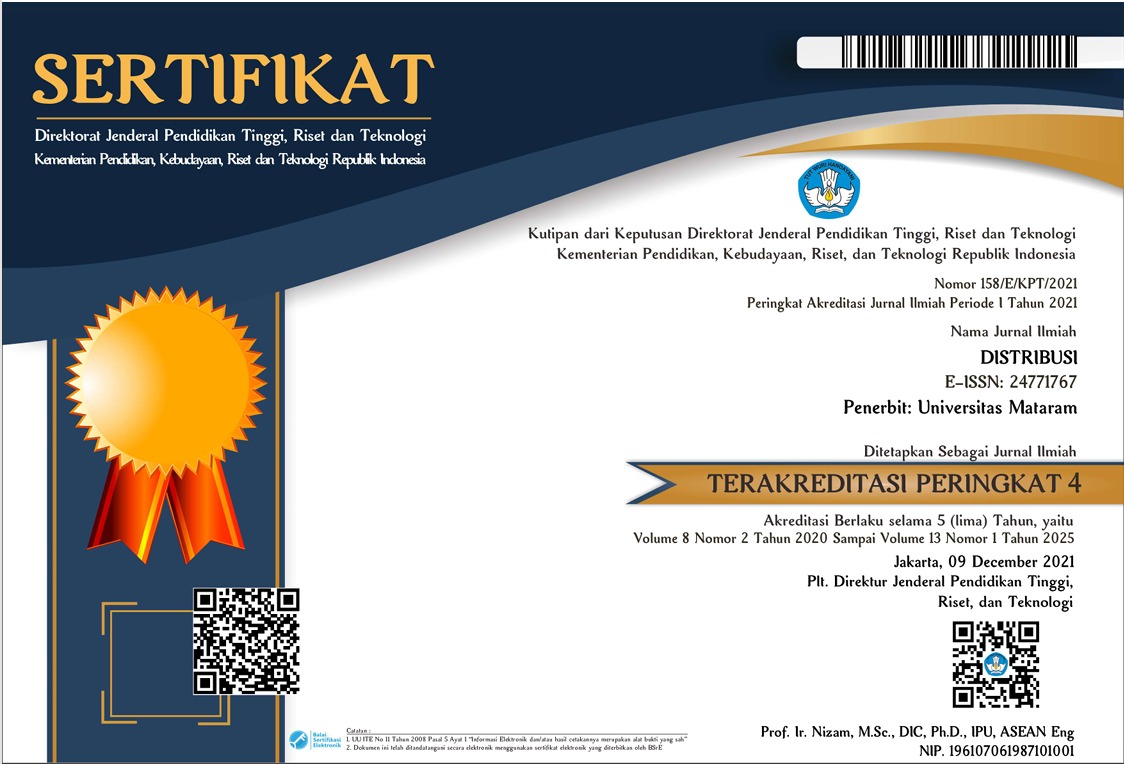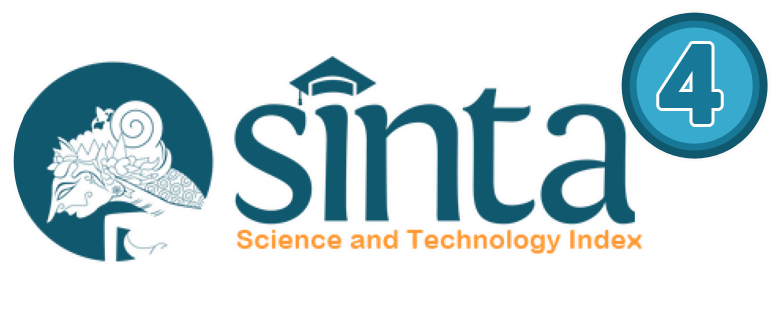DINAMIKA INOVASI PADA KLUSTER INDUSTRI PARIWISATA BALI MELALUI KERJASAMA PEMERINTAH-UNIVERSITAS-INDUSTRI
DOI:
https://doi.org/10.29303/distribusi.v4i2.14Abstract
ABSTRAK
Pariwisata menjadi topik yang diagendakan di Indonesia seperti di Bali dimana pembangunan ekonomi yang didukung oleh master rencana untuk ekspansi dan percepatan pembangunan ekonomi indonesia tahun 2011-2025. Hal ini disebutkan dalam koridor pembangunan nomor 5 disebut koridor pariwisata dan sumber pangan nasional di mana bali termasuk ke kawasan wisata pembangunan. Dalam mengembangkan pariwisata berkelanjutan di Bali diperlukan strategi pembangunan ekonomi, inovasi bermain peran penting. Oleh karena itu , tujuan penelitian ini adalah untuk mengidentifikasi inovasi di dalam industri kerajinan cluster indonesia sebagai salah satu bagian industri pariwisata. Kerangka survei perusahaan untuk diidentifikasi adalah perusahaan yang melakukan kegiatan inovasi di dalam cluster. Survei 33 pemilik perusahan dan eksekutif dengan menggunakan kuesioner dan teknik in-depth interview digunakan untuk mengeksplorasi tingkat kegiatan inovasi. Hasil penelitian mengidentifikasi banyak jenis inovasi dilakukan. Inovasi telah banyak didukung oleh banyak lembaga dalam industri cluster kerajinan di Bali. Jejaring yang kompleks telah menyiapkan lebih banyak pengetahuan dan teknologi bagi cluster industri kerajinan di Bali. Oleh karena itu, temuan dalam penelitian ini adalah adanya hubungan diantara lembaga maupun institusi kerajinan di Bali.
Kata Kunci: Cluster, Inovasi, UMKM, Industri Kreatif, Industri Kerajinan
ABSTRACT
Tourism has became topical agenda in Indonesia as well as in Bali Economic development which is supported by the Master Plan for Expansion and Acceleration of the Indonesia Economic Development 2011-2025. It is mentioned in corridor of development number 5 called Tourism & Food National Support Corridor where Bali is included to the tourism area development. In order to develop sustainable tourism for the Bali economic development strategy, innovation play important role. Therefore, aim of this research is to identify innovation activities in the Indonesian craft industrial cluster as one of the broad tourism industry players. A framework of company survey was taken to identify their innovation activities in the cluster. Survey of 33 company owners and executives using quessionaires and in-depth interview technique explores their level of innovation activities. Thus research result found many types of innovation presented on the paper. Those types of innovation has been supported by many institutions in the Balinese craft industrial cluster. The more complex network has been set up the more knowledge and technology flows into the Balinese craft industrial cluster. Therefore, new types of inter-relationship among institutions in the Balinese craft industry is called innovation in the research .
Keywords: Cluster, Innovation, SMEs, Creative industry, Handicraft industry
Downloads
References
Arrow, K. J.; “The Economic Implications of Learning by Doing,” Review of Economic Studies, vol.29, pp. 155-173, 1962.
Avermaete, T., Viaene, J., Morgan, E.J. and Crawford, N.;”Determinants of innovation in small food firms”, European Journal of Innovation Management, vol.6 (1), pp. 8-17, 2003.
Barro, R. J.; “Economic Growth in a Cross Section of Countries,” Quarterly Journal of Economics, vol.106, pp. 407-443, 1991.
Barry, C.R. and E.L. Glaeser, “The Divergence of Human Capital Level across Cities,” NBER, working paper no. 11617, 2005.
Becker, G.; Human Capital: A Theoretical and Empirical Analysis, with Special Reference to Education., New York: Columbia University Press for NBER, 1964.
Bergman, E. and Feser, E. Industrial and Regional Cluster: Concept and Comparative Applications, Regional Research Institute, West Virginia University, 1999.
Best, Michael.:The New Competition. Cambridge, MA: Harvard University Press, 1990.
Burn, T. & Stalker.;The management of innovation, London, England: Tavistock, 1971.
Department for Culture , Media, and Sport (DCMS); Creative Industries Mapping Document. London, England: Author, 1998.
Drucker, P.F.; “The Dicipline of innovation,” Harvard Business Review, vol. 63(3), pp. 67-72, 1985.
DTI; Building the Knowledge Driven Economy.Department of Trade and Industry, HMSO, London, 1998.
Enright, M.; “The Globalization of Competition and the Localization of Competitive Advantage: Policies toward Regional Clustering,” in. Globalization of Multinational Enterprise and Economic Development, Hood, N. and Young S Macmillan, Ed. London,2000.
Feser, E.; “Old and New Theories of Industry Clusters,” in Clusters and Regional Specialisation, Steiner, M. Pion Limited, Ed. London (1998).
Florida, R.; The rise of the creative class. New York: Basic Books, 2002.
Florida, R., Mellander and K. Stolarick.; “Inside the Black Box of Regional Development- Human Capital, the Creative Class and Tolerance,” Journal of Economic Geography, vol.8, pp. 615-649, 2008.
German Comission for UNESCO; Training strategies for world heritage management. Bonn,Germany: Author, 2007.
Handke, C.; “On peculiarities of innovation in cultural industries,” Paper presented at 15th International conference on cultural economics, Northeastern University, Boston,MA , 2008.
Held, J.; “Clusters as an Economic Development Tool: Beyond the pitfalls,” Economic Development Quarterly, Vol. 10, pp. 249-261, 1996.
Howkins, J.; The creative economy.;How people make money from ideas. London: Penguin Books, 2001.
Jacob, J.; The Death and Life of Great American Cities. New York: Random House, 1992.
Kuster, L., & Vila, N.; “The Market orientation-Innovation-Success relationship: “The role of internationalization strategy,” Innovation: Management, Policy & Practice, vol.13 (1), pp. 36-54, 2011.
Johannessen,J.A., Dolva J.O. and Kolvereid,L.; ”Perceive Innovation Success in the Russian Market,” International Journal of Information Management vol.17(1), pp.13-20 , 1997.
Lucas, R, “Ideas and growth,” NBER, working paper series no 14133, 2008.
Mellander C. and R. Florida, “The Creative Class or Human Capital? Explaining Regional Development in Sweden,” CESIS, Working Paper Series No. 79, 2007.
Miles,I., & Green, L.; Hidden innovation in the creative industries. London,England: NESTA, 2008.
Morrison, A.; “Gate Keeper of Knowledge within Industrial District: Who They Are, How They Interact,” Regional Studies, vol.42: pp.817-835, 2008.
Neely, A., Filippini,R., Forza,C., Vinelli,A. and Hii,J.A.: ”Framework for analysing business performance, firm innovation and related contextual factor; Perception of managers and policy makers in two European regions,” Integrated manufacturing Systems, vol. 12(2), pp.114-124, 2001.
Nohria, N, “Is a Network Perspective a Useful Way of Studying Organizations?,” Working paper, Harvard Business School, 1992.
Porter, M.E.; On Competition. Harvard Business Review, Harvard School Press, Pp197-287, 1998.
Rogers, E.M. Diffusion of innovation.New York; The free press (1998).
Scottish Enterprise;The Cluster Approach: Powering the Scotland’s Economy into the 21st Century. Scottish Enterprise, Glasgow, 1998.
Saxenian, AnnaLee.; “Regional Networks and the Resurgence of Silicon Valley,” California Management Review, vol.33(1), pp. 89-112, 1990.
Schultz, T. W.; “Investment in Human Capital,” American Economic Review, vol.51, pp. 1-17, 1961.
Stoneman, P.; An Introduction to the definition and measurement of soft innovation. London, England: NESTA, 2007.
Tambunan, T.; “Promoting small and medium enterprises with clustering approach: A policy experiences from Indonesia,” Journal of Small Business Management, vol. 43(2), pp. 138-154, 2005.
Wright, T., Boria, E.,& Breidenbach, P. Creative player action in FPS onlinevideo games- playing counter-strike. Game studies. Retrieved 2014 http://www.gamestudies.org/0202/wright
Zackariasson, P., Walfisz, M.,& Wilson, T.L Management of creativity in video game development: A case study. Services marketing quarterly, vol.27, pp.73-97, 2006.
Downloads
Published
How to Cite
Issue
Section
License
Penulis yang naskahnya diterbitkan menyetujui ketentuan sebagai berikut:
- Hak publikasi atas semua materi naskah jurnal yang diterbitkan/dipublikasikan dalam situs Jurnal DISTRIBUSI ini dipegang oleh dewan redaksi dengan sepengetahuan penulis (hak moral tetap milik penulis naskah).
- Ketentuan legal formal untuk akses artikel digital jurnal elektronik ini tunduk pada ketentuan lisensi Creative Commons Attribution-ShareAlike (CC BY-SA), yang berarti Jurnal DISTRIBUSI berhak menyimpan, mengalih media/format-kan, mengelola dalam bentuk pangkalan data (database), merawat, dan mempublikasikan artikel tanpa meminta izin dari Penulis selama tetap mencantumkan nama Penulis sebagai pemilik Hak Cipta.
- Naskah yang diterbitkan/dipublikasikan secara cetak dan elektronik bersifat open access untuk tujuan pendidikan, penelitian, dan perpustakaan. Selain tujuan tersebut, dewan redaksi tidak bertanggung jawab atas pelanggaran terhadap hukum hak cipta.









